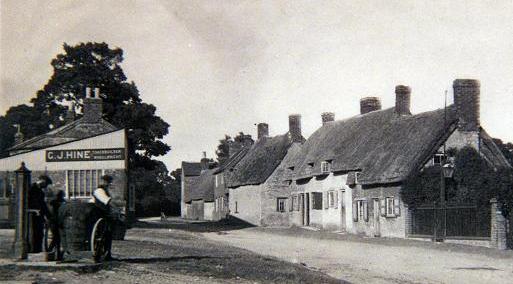
George James Hine’s wheelwrights was situated at the bottom end of Church Road, next to the Knoll where Knoll Close is today. George was born in Sherington in 1871, the son of James (an agricultural labourer) and Sarah (a lacemaker) Hine, and was married to Clare Boon.
The Hine’s are a well-established Sherington family:
1841 census – 1 family member listed
1851 census – 8 family members (surname given as ‘Hind’)
1861 census – 11 family members
1871 census – 10 family members (surname given as ‘Hyne’)
1881 census – 10 family members
1891 census – 9 family members
1901 census – 10 family members
St Laud’s Monument Inscriptions – 10 family members.
The business is listed in the 1895 to 1907 Kelly directories as ‘Wheelwrights and coach builders’, in 1911 to 1924 as ‘Coachbuilders’ and 1928 to 1939 as ‘wheelwrights’.
Hine’s Wheelwrights in 1920
The following letter was written by Mr C. G. Mynard about a time in 1920 when he became employed by G. J. Hine the Sherington cart maker and wheelwright.
During October 1920, I became employed by G. J Hine (Wheelwright and Coachbuilder) who specialised in building 2 classes of floats, the odd traps, heavy farm carts and repairs to everything that came along, including E & H Roberts elevators.
Mr Hine had 1 circular saw, 1 band saw and a lathe which was used to turn the hubs. Most of the timber (came) in large planks. Heavy cart shaft planks were 8 feet long 4 ins thick, and five shafts could be cut out of one plank, which was too wide for the band saw table. So I had to hand saw down the centre of the plank, it took me over two hours. All the wood for the bodies were planed and dimensioned by hand. The spokes for the wheels were all shaped by hand. The rims were band sawed to size and shape, and stacked twelve months before use.
There was a lot of iron worked, which Bill Clarke (Blacksmith) made. Bill also bent and welded the various size tyres, which (were) heated and put on wheels, on a special platform in his yard. There was the painting of the vehicles. Floats were varnished, iron work painted black. The best class of float had rubber tyres. A lot of people used them for private use.
Mr Hine & Phil Middleweek took one of the best floats to Ampthill Show, took 1st Prize, and sold it immediately.
Signed C. G. Mynard
